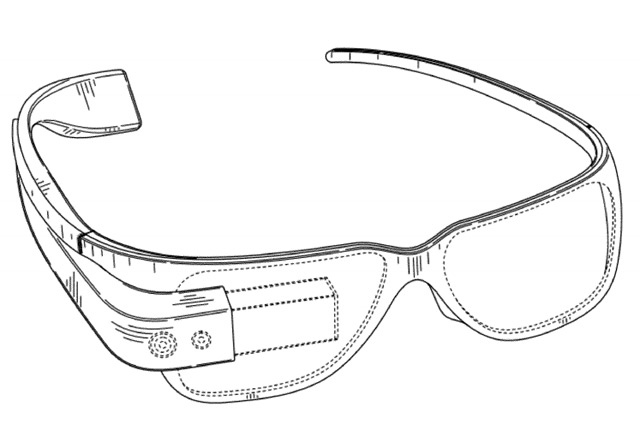Thursday, 26 December 2013
Google Project Glass


Google's Android operating system allows user tointeract with app icons through the frameless, glassless interface, effectively augmenting reality.

E-Bra

From the University of Arkansas, this e-bra tracks your health stats, such as your heart rate, and sends them to your smart phone for tracking and number crunching.
Motorola password pill
The Motorola password pill. Since becoming part of Google, Motorola has been spitting out all kinds of interesting ideas. It's a commonly accepted idea that the days of written passwords are numbered; but Motorola's alternative is genuinely innovative, if totally creepy at the same time. The edible password pill contains a tiny chip that is powered by the acid in your stomach - it then emits a signal similar to an electrocardiogram (ECG) which can be uniquely identified by your phone, tablet or computer. It is approved as safe by the US FDA, but is unlikely to be released in the near future.




- MOTOROLA DEBUTS EDIBLE PASSWORD PILL FOR DEVICES
Monday, 23 December 2013
Thursday, 19 December 2013
Career scope after B.Tech EEE in India
After B.Tech we can choose
Higher
studies:
1. M .Tech in
IITs, IISc, NIT
Gate coaching
in Hyderabad, New Delhi.We can get
good coaching for GATE 2013. So that we can get placed in core companies based
on GATE score or we can join M.Tech in top universities.
List of some
good institutes in New Delhi, Hyd:
1.
Engineers Institute of India
(A team of IES & GATE Toppers)28B/7, Jia Sarai (Near IIT),Hauz Khas , New Delhi 110016
Ph. 0-9990657855 , 9891181190
Website: www.engineersinstitute.com
E-mail: info@engineersinstitute.com
(A team of IES & GATE Toppers)28B/7, Jia Sarai (Near IIT),Hauz Khas , New Delhi 110016
Ph. 0-9990657855 , 9891181190
Website: www.engineersinstitute.com
E-mail: info@engineersinstitute.com
2.
I.E.S. Made Easy
MADE EASY Education Pvt. Ltd.44-A / 1, Kalu Sarai (Sarvapriya Vihar) New Delhi – 110016.
Phone: Delhi : 011-45124612 , 09958995830
Noida :0120-6524612 , 0-8860378009
Bhopal : 0-8860378008 , 0-9810541651
Hyderabad: 040-20032005 , 0-9160002324
Email id - iesmadeeasy@yahoo.co.in
MADE EASY Education Pvt. Ltd.44-A / 1, Kalu Sarai (Sarvapriya Vihar) New Delhi – 110016.
Phone: Delhi : 011-45124612 , 09958995830
Noida :0120-6524612 , 0-8860378009
Bhopal : 0-8860378008 , 0-9810541651
Hyderabad: 040-20032005 , 0-9160002324
Email id - iesmadeeasy@yahoo.co.in
These institutes also providing coaching for
engineering services exam=program&sno=13
M.Tech in Energy
Systems:
It is being offered by UPES University of Petroleum and
Services, Dehradun.For details go to this link
M.Tech in Electronics
design & technology:
This course is being offered by National institute of
electronics and information technologyFor details use it
Post graduate diploma
in tool design (electrical):
This course is being offered by one of the leading Indian
institute in Maharashtra “IDEMI(institute for design of electrical measuring
instruments)”
For details click this link
Same institute also offering automation courses
For details use this link
Pg diploma in tool design is also offered by NTTF. It also
offering other pg diploma courses.
Details can be found in this link
pg diploma in energy management:
It is one year course being offered by Indian institute of production management.
Pg diploma in thermal
power plant engineering by NPTI:
NPTI is the top most institutes in giving pure electrical
trainings. It is offering various pg diploma courses.
Pg diploma in power plant engineering by JSW centres of
Excellence:
For details link- http://www.jswel.net/pgac_program_overview.html
Thermal power plant training by OMSPTRI
For details - http://www.omstraining.net/courses_offered.php
NOTE: NPTI, JSW,
OMSPTRI courses are CEA (central electricity authority of India) certified
courses which give us more advantage in getting core jobs.
EDPTI Engineering Design & Power
Training Institute :
It
is offering various electrical design courses and power plant courses, and also
inspection and safety courses with good placement assistance.
Link- http://www.edpti.com/
If
you are interested in designing sector:
Try
for CEED2013 it was an entrance exam conducted for admissions in M.Tech in
industrial design, animation design etc. search in Google for more details.
If you interested in fashion designing textile designing:
You can choose
NID
national institute of design
NIFT
national institute of fashion technology
Pearl
academy New Delhi
If
you are interested in multimedia technologies, visual effects , gaming etc
You
can choose
Pg
diploma courses in ICAT
www.icat.ac.in/index.asp
Entrance tests information:
BARC
last date 31st April (this is absolutely free for girls.)
Link-
http://www.barconlineexam.in/
NPTI PGDC CET-2012
Exam on June 10th
Link
- http://www.nptinagpur.com/
DRDO
exam
Refer
employment news.
http://www.employmentnews.gov.in/
NOTE: for regular updating of lob
posts, government sector entrance exams keep on refer employment news.
According
to my knowledge this information is given to you. Please go through it once.
Choose you way after B.Tech.
Wishing
that success will come to everyone of us .
All the best
Wednesday, 18 December 2013
Power systems 2013 projects
- SPACE VECTOR MODULATION CONTROLLED HYBRID ACTIVE POWER FILTER FOR POWER CONDITIONING. 2013 POWER SYSTEMS
- MODELLING, SIMULATION AND CONTROL OF A NON CONVENTIONAL FUEL CELL POWER GENERATION SYSTEM BY VARYING OXYGEN PRESSURE USING MATLAB 2013 POWER SYSTEMS
- MITIGATION OF HARMONICS BY HYSTERESIS CONTROL TECHNIQUE OF VSI BASED STATCOM 2013 POWER SYSTEMS
- SLIDING MODE CONTROL FOR PMSG BASED DYNAMIC VOLTAGE RESTORER 2013 POWER SYSTEMS
- DEVELOPMENT OF A SOLAR CELL MODEL IN MATLAB FOR PV BASED GENERATION SYSTEM 2013 POWER SYSTEMS
- UNBALANCED FAULT ANALYSIS OF DOUBLY FED INDUCTION GENERATOR DRIVE SYSTEM FOR WIND TURBINE APPLICATIONS 2013 POWER SYSTEMS
- THE DIRECT CURRENT CONTROL METHOD OF STATCOM AND IT’S SIMULATION 2013 POWER SYSTEMS
- CO-ORDINATION OF SMES WITH STATCOM FOR MITIGATING SSR AND DAMPING POWER SYSTEM OSCILLATIONS IN A SERIES COMPENSATED WIND POWER SYSTEM 2013 POWER SYSTEMS
- INTEGRATION OF PV/BATTERY HYBRID ENERGY CONVERSION SYSTEM TO THE GRID WITH POWER QUALITY IMPROVEMENT FEATURES 2013 POWER SYSTEMS
- OPEN-END-WINDING PMSG FOR WIND ENERGY CONVERSION SYSTEM WITH DUAL BOOST NPC CONVERTER 2013 POWER SYSTEMS
- MITIGATION OF CAPACITOR BANK SWITCHING TRANSIENTS BY USING SVCS IN LARGE PLANTS INSTEAD OF CAPACITOR BANK AND CIRCUIT BREAKER 2013 POWER SYSTEMS
- A NOVEL ANALYSIS OF HIGH FREQUENCY LLC CONVERTER FOR FUEL CELL SYSTEMS 2013 POWER SYSTEMS
- INTERLEAVED SOFT SWITCHING BOOST CONVERTER WITH MPPT FOR PHOTOVOLTAIC POWER GENERATION SYSTEM 2013 POWER SYSTEMS
- CONTROL AND QUANTIFICATION OF KINETIC ENERGY RELEASED BY WIND FARMS DURING POWER SYSTEM FREQUENCY DROPS 2013 POWER SYSTEMS
- A NEW MULTI-LEVEL INVERTER WITH FACTS CAPABILITIES FOR WIND APPLICATIONS 2013 POWER SYSTEMS
- SIMULATION FOR PERFORMANCE ANALYSIS OF GRID-CONNECTED INDUCTION GENERATORS WITH INPUT VOLTAGE CONTROL 2013 POWER SYSTEMS
- VOLTAGE AND FREQUENCY CONTROL OF WIND HYDRO HYBRID SYSTEM IN ISOLATED LOCATIONS USING CAGE GENERATORS 2013 POWER SYSTEMS
- OPERATION AND CONTROL OF WIND/FUEL CELL BASED HYBRID MICROGRID IN GRID CONNECTED MODE 2013 POWER SYSTEMS
- DESIGN, ANALYSIS AND SIMULATION OF SMALL SIGNAL CONTROL STRATEGY OF A STATCOM FOR REACTIVE POWER COMPENSATION ON VARIATION OF DC LINK VOLTAGE 2013 POWER SYSTEMS
- PERFORMANCE INVESTIGATION OF DYNAMIC VOLTAGE RESTORER USING PI AND FUZZY CONTROLLER 2013 POWER SYSTEMS
- DISTURBANCE IMMUNE DFIG BASED WIND ENERGY CONVERSION SYSTEM 2013 POWER SYSTEMS
- VOLTAGE SAG/SWELL COMPENSATION USING Z-SOURCE INVERTER DVR BASED ON FUZZY CONTROLLER 2013 POWER SYSTEMS
- CONSTANT OUTPUT UNDER TRANSIENT CONDITION IN WIND TURBINE USING NOVEL BOOST CONVERTER 2013 POWER SYSTEMS
- MODULAR MULTILEVEL CASCADE CONVERTER BASED STATCOM FOR REACTIVE POWER COMPENSATION 2013 POWER SYSTEMS
- MODELING AND SIMULATION IN WIND ELECTRIC GENERATOR USING SIMULINKLMATLAB 2013 POWER SYSTEMS
- MULTIPLE INPUT DC-DC CONVERTERS FOR SOLAR CELL POWER SUPPLY SYSTEM AND ITS MAXIMUM POWER POINT TRACKER 2013 POWER SYSTEMS
- A NEW APPROACH FOR VOLTAGE CONTROL OF IPFC AND UPFC FOR POWER FLOW MANAGEMENT 2013 POWER SYSTEMS
- DYNAMIC PERFORMANCE INVESTIGATION OF D–Q MODEL WITH PID CONTROLLER-BASED UNIFIED POWER-FLOW CONTROLLER 2013 POWER SYSTEMS
- A SINGLE-PHASE 5-LEVEL INVERTER WITH FACT CAPABILITY USING MODULAR MULTI-LEVEL CONVERTER (MMC) TOPOLOGY 2013 POWER SYSTEMS
- MODEL PREDICTIVE CONTROL OF GRID-TIED FOUR-LEVEL DIODE-CLAMPED INVERTERS FOR HIGH POWER WIND ENERGY CONVERSION SYSTEMS 2013 POWER SYSTEMS
- MODELING AND SIMULATION OF SINGLE PHASE FIVE LEVEL INVERTER FED FROM RENEWABLE ENERGY SOURCES 2013 POWER SYSTEMS
- DESIGN, ANALYSIS AND SIMULATION OF LINEAR CONTROLLER OF A STATCOM FOR REACTIVE POWER COMPENSATION ON VARIATION OF DC LINK VOLTAGE 2013 POWER SYSTEMS
- APPLICATION OF STATCOM FOR TRANSIENT STABILITY IMPROVEMENT AND PERFORMANCE ENHANCEMENT FOR A WIND TURBINE BASED INDUCTION GENERATOR 2013 POWER SYSTEMS
- IMPROVEMENT OF POWER QUALITY BY USING ACTIVE FILTER BASED ON VECTORIAL POWER THEORY CONTROL STRATEGY ON THE MATLAB-SIMULINK PLATFORM 2013 POWER SYSTEMS
- CASCADED SEVEN LEVELS H-BRIDGE INVERTER CONTROL OF DSTATCOM FOR COMPENSATION OF REACTIVE POWER AND HARMONICS 2013 POWER SYSTEMS
- COMPARATIVE STUDY BETWEEN DIFFERENT CONTROL STRATEGIES FOR SHUNT ACTIVE POWER FILTER 2013 POWER SYSTEMS
- STATIC SYNCHRONOUS SERIES COMPENSATOR FOR SERIES COMPENSATION OF EHV TRANSMISSION LINE 2013 POWER SYSTEMS
- DESIGN AND SIMULATION OF STAT-COM TO IMPROVE POWER QUALITY 2013 POWER SYSTEMS
- IMPACTS OF D-STAT-COM ON VOLTAGE STABILITY 2013 POWER SYSTEMS
- DECOUPLING CONTROL STRATEGY OF D-STAT-COM 2013 POWER SYSTEMS
Sunday, 15 December 2013
Parts of HVDC link
These HVDC transmission systems are specifically used to:
economically transmit electrical energy over long distances via overhead lines or cable,
connect asynchronous grids or grids with different frequencies.
connect asynchronous grids or grids with different frequencies.

1 AC Switchyard
2 AC Filters, Capacitor Banks
3 Converter Transformers
4 Converters
5 Smoothing Reactors
Saturday, 14 December 2013
Tan delta ,Resistivity measurement of transformer oil
Insulating oil in an electrical power transformer is commonly known as Transformer Oil. It is normally obtained by fractional distillation and subsequent treatment of crude petroleum. That is why this oil is also known as Mineral Insulating Oil. Transformer Oil serves mainly two purposes one it is liquid insulation in electrical power transformer and two it dissipates heat of the transformer i.e. acts as coolant. In addition to these, this oil serves other two purposes, it helps to preserve the core and winding as these are fully immersed inside oil and another important purpose of this oil is, it prevents direct contact of atmospheric oxygen with cellulose made paper insulation of windings, which is susceptible to oxidation.
1. Electrical Parameters – Dielectric Strength , Specific Resistance, Dielectric Dissipation Factor.








1. Electrical Parameters – Dielectric Strength , Specific Resistance, Dielectric Dissipation Factor.
2. Chemical Parameter - Water Content, Acidity, Sludge Content.
3. Physical Parameters - Inter Facial Tension, Viscosity, Flash Point, Pour Point.
Dielectric Strength of Transformer Oil

Dielectric Strength of Transformer Oil is also known as Breakdown Voltage of transformer oil or BDV of transformer oil. Break down voltage is measured by observing at what voltage, sparking strants between two electrods immerged in the oil, separated by specific gap. low value of BDV indicates presence of moisture content and conducting substances in the oil. For measuring BDV of transformer oil, portable BDV measuring kit is generally available at site. In this kit, oil is kept in a pot in which one pair of electrodes are fixed with a gap of 2.5 mm (in some kit it 4mm) between them.
Specific Resistance ( Resistivity ) of Transformer Oil
This is another important property of transformer oil. This is measure of DC resistance between two opposite sides of one cm3 block of oil. Its unit is taken as ohm-cm at specific temperature. With increase in temperature the resistivity of oil decreases rapidly. Just after charging a transformer after long shut down, the temperature of the oil will be at ambient temperature and during full load the temperature will be very high and may go up to 90oC at over load condition. So resistivity of the insulating oil must be high at room temperature and also it should have good value at high temperature as well.
That is why specific resistance or resistivity of transformer oil should be measured at 27oC as well as 90oC.
That is why specific resistance or resistivity of transformer oil should be measured at 27oC as well as 90oC.
Transformer winding resistance measurement
Transformer winding resistance measurement is carried out to calculate the I2R losses and to calculate winding temperature at the end of a temperature rise test. It is carried out as a type test as well as routine test. It is also done at site to ensure healthiness of a transformer that is to check loose connections, broken strands of conductor, high contact resistance in tap changers, high voltage leads and bushings etc.
There are different methods for measuring of transformer winding, likewise
♣ Current voltage method of measurement of winding resistance.
♣ Bridge method of measurement of winding resistance.
♠ Kelvin bridge method of Measuring Winding Resistance.
♣ Current voltage method of measurement of winding resistance.
♣ Bridge method of measurement of winding resistance.
♠ Kelvin bridge method of Measuring Winding Resistance.
Transformer winding resistance measurement is carried out as a type test, routine test and also as a field test.
In the factory, it helps in determining the following :
(a) Calculation of the I2R losses in transformer
(b) Calculation of winding temperature at the end of temperature rise test of transformer.
(c) As a benchmark for assessing possible damages in the field.
In the factory, it helps in determining the following :
(a) Calculation of the I2R losses in transformer
(b) Calculation of winding temperature at the end of temperature rise test of transformer.
(c) As a benchmark for assessing possible damages in the field.
Current Voltage Method of measurement of winding resistance
The transformer winding resistances can be measured by current voltage method. In this method of measurement of winding resistance, the test current is injected to the winding and corresponding voltage drop across the winding is measured.
By applying simple Ohm's law i.e. Rx = V ⁄ I, one can easily determine the value of resistance.


Dielectric Dissipation Fact
Bridge Method of measurement of winding resistance

The main principle of bridge method is based on comparing an unknown resistance with a known resistance.
When electric currents flowing through the arms of bridge circuit become balanced, the reading of galvanometer shows zero deflection that means at balanced condition no electric current will flow through the galvanometer. Very small value of resistance ( in milli - ohms range) can be accurately measured by Kelvin Bridge method whereas for higher value Wheatstone bridge method of resistance measurement is applied. In bridge method of measurement of winding resistance, the errors is minimized.




Loss factor or tan delta of Transformer oil
Dielectric Dissipation Factor is also known as loss factor or tan delta of transformer oil. When a insulating materials is placed between live part and grounded part of an electrical equipment, leakage current will flow. As insulating material is dielectric in nature the electric currentthrough the insulation ideally leads the voltage by 90o. Here voltage means the instantaneous voltage between live part and ground of the equipment. But in reality no insulating materials are perfect dielectric in nature. Hence electric current through the insulator will lead the voltage with an angle little bit shorter than 90o. Tangent of the angle by which it is short of 90o is called Dielectric Dissipation Factor or simplytan delta of transformer oil.
More clearly, the leakage current through an insulation does have two component one is capacitive or reactive and other one is resistive or active.
Again it is clear from above diagram, value of ′δ′ which is also known as loss angle,

is smaller, means resistive component of the current IR is smaller which indicates high resistive property of the insulating material. High resistive insulation is good insulator. Hence it is desirable to have loss angle as small as possible. So we should try to keep the value of tanδ as small as possible. High value of this tanδ is an indication of presence of contaminants in transformer oil.
Hence there is a clear relationship between tanδ and resistivity of insulating oil. If resistivity of the insulating oil is decreased, the value of tan-delta increases and vice verse. So both resistivity test and tan delta test of transformer oil are not normally required for same piece of insulator or insulating oil.
In one sentence it can be said that, tanδ is measure of imperfection of dielectric nature of insulation materials like oil.

is smaller, means resistive component of the current IR is smaller which indicates high resistive property of the insulating material. High resistive insulation is good insulator. Hence it is desirable to have loss angle as small as possible. So we should try to keep the value of tanδ as small as possible. High value of this tanδ is an indication of presence of contaminants in transformer oil.
Hence there is a clear relationship between tanδ and resistivity of insulating oil. If resistivity of the insulating oil is decreased, the value of tan-delta increases and vice verse. So both resistivity test and tan delta test of transformer oil are not normally required for same piece of insulator or insulating oil.
In one sentence it can be said that, tanδ is measure of imperfection of dielectric nature of insulation materials like oil.
Subscribe to:
Posts (Atom)





























